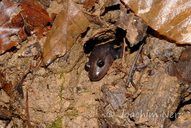|
Phaeognathus hubrichti Highton, 1961
Red Hills Salamander | family: Plethodontidae subfamily: Plethodontinae genus: Phaeognathus |
 © 2017 Dr. Joachim Nerz (1 of 12) |
|
|
|
Description Distribution and Habitat Country distribution from AmphibiaWeb's database: United States U.S. state distribution from AmphibiaWeb's database: Alabama
Habitat preferred by Phaeognathus hubrichti is steep, mesic ravines shaded by a mature hardwood overstory (Jordan 1975; Schwaner and Mount 1970) P. hubrichti is almost entirely fossorial and appears to be found most often in areas of soft soil which allows burrowing. P. hubrichti burrows are often most abundant on the steepest regions of slopes (Valentine 1963b). Burrows are subject to constant erosion and burrow openings may only last a few motnhs, at which point the salamander must repair or reconstruct its burrow (Gunzburger and Guyer 1998). Life History, Abundance, Activity, and Special Behaviors Phaeognathus hubrichti are often observed sitting with just their head visible at the entrance of their burrow on moist nights. P. hubrichti probably forages opportunistically on any prey item that passes by the burrow entrance or enters the burrow. Diet of P. hubrichti consists of a variety of invertebrates including snails, beetles, ants, millipedes, and spiders (Brandon 1965; Gunzburger 1999). Analysis of proteins from individuals from 13 populations of Phaeognathus hubrichti throughout their range suggests that there are 2 distinct geographic groups (McKnight et al. 1991). An effort to conserve population within both of these groups should be attempted. Trends and Threats Relation to Humans http://archives.state.al.us/emblems/st_amphib.html Possible reasons for amphibian decline General habitat alteration and loss Comments
References
Brandon, R. A. (1965). ''Morphological variation and ecology of the salamander Phaeognathus hubrichti.'' Copeia, 1965(1), 67-71. Brandon, R. A. and Maruska, E. J. (1982). ''Phaeognathus hubrichti (Red Hills Salamander) reproduction.'' Herpetological Review, 13(2), 46. Dodd, C. K., Jr. (1991). ''The status of the Red Hills Salamander Phaeognathus hubrichti, Alabama, USA, 1976-1988.'' Biological Conservation, 55(1), 57-75. French, T. W. and Mount, R. H. (1978). ''Current status of the Red Hills Salamander Phaeognathus hubrichti Highton, and factors affecting its distribution.'' Journal of the Alabama Academy of Science, 49(4), 172-179. Gunzburger, M. S. (1999). ''Diet of the Red Hills Salamander Phaeognathus hubrichti.'' Copeia, 1999(2), 523-525. Gunzburger, M. S. and Guyer, C. (1998). ''Longevity and abandonment of burrows used by the Red Hills Salamander Phaeognathus hubrichti.'' Journal of Herpetology, 32(4), 620-623. Highton, R. (1961). "A new genus of lungless salamander from the Coastal Plain of Alabama." Copeia, 1961(1), 65-68. Jordan, J. R., Jr. (1975). Observations on the Natural History and Ecology of the Red Hills Salamander Phaeognathus hubrichti Highton (Caudata: Plethodontidae). Unpublished dissertation, Auburn University, Auburn, Alabama. Jordan, J. R., Jr. and Mount, R. H. (1975). ''The status of the Red Hills Salamander Phaeognathus hubrichti Highton.'' Journal of Herpetology, 9(2), 211-215. McKnight, M. L., Dodd, C. K., Jr., and Spolsky, C. M. (1991). ''Protein and mitochondrial DNA variation in the salamander Phaeognathus hubrichti.'' Herpetologica, 47(4), 440-447. Mount, R. H. and Schwaner, T. D. (1970). ''A technique for collecting the plethodontid salamander Phaeognathus hubrichti.'' Copeia, 1970(1), 205-206. Parham, J. F., Dodd, C. K., Jr., and Zug, G. R. (1996). ''Skeletochronological age estimates for the Red Hills Salamander Phaeognathus hubrichti.'' Journal of Herpetology, 30(3), 401-404. Petranka, J. W. (1998). Salamanders of the United States and Canada. Smithsonian Institution Press, Washington D.C. and London. Schwaner, T. D. and Mount, R. H. (1970). ''Notes on the distribution, habits, and ecology of the Red Hills Salamander Phaeognathus hubrichti Highton.'' Copeia, 1970(3), 571-573. Valentine, B. D. (1963). ''The plethodontid salamander Phaeognathus: collecting techniques and habits.'' Journal of the Ohio Herpetological Society, 4(1-2), 49-54. Valentine, B. D. (1963). ''The plethodontid salamander Phaeognathus: external morphology and zoogeography.'' Proceedings of the Biological Society of Washington, 76, 153-158. Originally submitted by: Margaret S. Gunzburger (first posted 2001-03-25) Edited by: Ann T. Chang (2024-05-17) Species Account Citation: AmphibiaWeb 2024 Phaeognathus hubrichti: Red Hills Salamander <https://amphibiaweb.org/species/3931> University of California, Berkeley, CA, USA. Accessed Dec 28, 2024.
Feedback or comments about this page.
Citation: AmphibiaWeb. 2024. <https://amphibiaweb.org> University of California, Berkeley, CA, USA. Accessed 28 Dec 2024. AmphibiaWeb's policy on data use. |



 Raffaëlli Account
Raffaëlli Account Map of Life
Map of Life